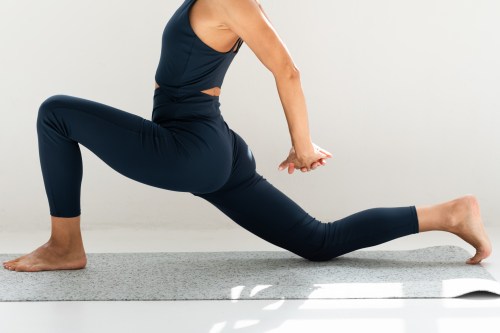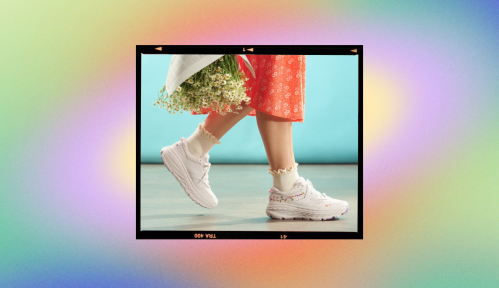When you’re moving into a pose and your yoga teacher gives you a form cue, it’s only natural to listen to what they say and try to do your best to follow it. Particularly if it’s a cue that you hear over and over again.
Experts in This Article
Meredith Witte, MSEP, CSCS, is an exercise physiologist and yoga teacher.
But what if we told you that there are some instructions that are regularly rattled off without actually being based in kinesiology (aka the study of human body movement)? You’d probably want to know what they are, right? We thought so. That’s why we chatted with exercise physiologist and yoga teacher Meredith Witte to debunk some of the biggest yoga form myths once and for all.
1. “Relax the glutes”
Backbends (known as Urdhva Dhanurasana or wheel pose) are common in many practices, like Ashtanga. But Witte suggests approaching them with caution. “Our lower back is designed to be stable, not mobile, yet most backbends require deep, passive hyperextension of the lower back,” she says. If practiced regularly, they could lead to lower back pain.
Because of this, she says that a common cue that drives her crazy is to “relax the glutes” or “soften the glutes” while in a backbend or in bridge pose. “The glutes are the primary driver of your hips up away from the floor, so if you relax them, you’re just dumping pressure into your lower back,” she warns.
“I rarely teach backbends, but if I do, I give a lot of cueing around extending from the upper back (which is anatomically designed to have much more mobility in relation to the lower back) and engaging the glutes for support,” Witte says.
2. “Breathe down into your belly”
All forms of yoga incorporate mindful breathing and most times, instructors tell participants to breathe into their belly in an attempt to keep them from lifting their shoulders and expanding their chests with shallower breaths. While it’s true that you want to be cognizant of how you’re breathing while practicing yoga, Witte says that the “breathe down into your belly” cue is often misunderstood.
“I’ve found that, particularly with newer students, if they are being told to ‘breathe into the belly,’ there’s a tendency to tense through the abdomen and create unnecessary intra-abdominal pressure in order to give the visual of a rise and fall,” she says. “This is really the opposite result of what we’re aiming for in moments of calm, downregulating breathwork.”
With this in mind, Witte says she prefers to tell students to put their hands on their ribcage and explore, without pushing or forcing, if they can feel their ribs expanding under their hands. “When we are breathing, our lungs expand, our ribcage expands, and our diaphragm presses downward,” she explains. So, as long as you can feel your ribcage expand, and so long as you’re not taking shallow upwards breaths into your chest, you’ll be breathing into your belly.
3. “Put a pillow under your butt.”
If you don’t have quite enough mobility to comfortably achieve pigeon pose (in which one leg is folded in front of your chest while your other leg is extended out behind you on the floor), thus leaving your hips in the air, your instructor may tell you to put a pillow under your butt.
“While this might feel more comfortable, the tissues on your outer [bent] knee, which are meant to provide stability, are likely overly stretched,” Witte warns. “I always suggest putting a bolster vertically on your mat underneath both your hip and knee, so that the knee and hip are parallel, and your knee isn’t compensating for whatever mobility you’re lacking in your hip.”
4. “If you’re tight, you need to stretch more.”
With so much stretching incorporated into yoga, if you practice regularly, you might think that of course you should be limber enough to reach all the poses. In reality, Witte says that if you have a dedicated yoga practice and still feel tight, it’s likely not because of a lack of stretching.
Many yoga practices focus mainly on stretching the back side of your body, but include little to no strengthening work, she says. “So, after years of practicing yoga and stretching your hamstrings, your body will lack stability—oftentimes the sensation of tightness, especially amongst yogis, is actually a sign of this weakness.”
Without the stability and strength to support flexibility, the nervous system “tightens” as a protective mechanism, Witte explains. “My biggest piece of advice to those who stretch all the time is to try incorporating some strength work into your routine, especially for the glutes and hamstrings,” she says.
5. “Don’t let your knee go past your toes.”
Said in countless fitness classes, this phrase may feel like a second-nature reminder you often tell yourself during squats and lunges. According to Witte, though, it’s actually just a silly, antiquated rule.
“Our knees are designed to bend 180 degrees,” she points out. “You’re going to have to bend them 180 degrees when you squat down to roll up your mat after class, or when you sit down on the floor to put your shoes on…so why can’t you do it during class?”
In fact, Witte says that by limiting knee movement, it can actually dampen tissue capacity, which can make doing real-world activities like skiing and running around with little ones more challenging. So the next time an instructor spouts this supposed rule, know to your core that it’s based on lore, not really physiological fact.
Sign Up for Our Daily Newsletter
Get all the latest in wellness, trends, food, fitness, beauty, and more delivered right to your inbox.
Got it, you've been added to our email list.











